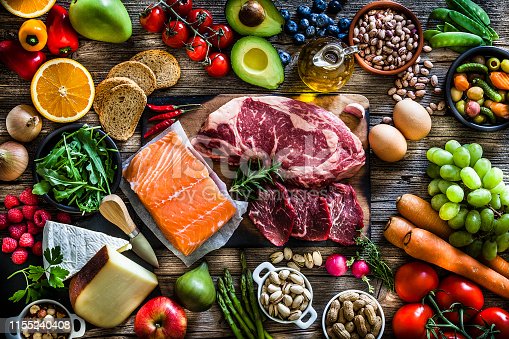Athletes, Bodybuilders, and the Atkins Advantage – A Deep Dive
For athletes and bodybuilders, nutrition isn’t just about fuelling workouts—it’s…
For athletes and bodybuilders, nutrition isn’t just about fuelling workouts—it’s about optimizing every aspect of your performance, recovery, and long-term health. Among the many dietary approaches out there, the Atkins Diet has earned a reputation for its low-carbohydrate focus and straightforward methodology. But what does that really mean for someone looking to get lean, boost performance, or prepare for competition? In this comprehensive guide, we’ll explore the four critical phases of the Atkins Diet, break down the differences between simple and complex carbohydrates, explain why calorie counting isn’t the whole story, and weigh the pros and cons for athletes. Whether you’re in your off-season, cutting weight, or even considering incorporating elements of the Atkins approach into your training, read on to learn how this diet might be the secret weapon you need.
1. Introduction: Nutrition Meets Performance
When it comes to sculpting the perfect physique, every detail counts. Athletes and bodybuilders understand that training hard is only half the battle—the real magic happens in the kitchen. Nutrition is the fuel that powers every rep, set, and sprint. And while many diets emphasize calorie counting or balanced macronutrient distribution, the Atkins Diet takes a different approach. It zeroes in on carbohydrate restriction as a way to shift your body’s metabolism into a fat-burning mode.
Originally developed for weight loss, the Atkins Diet has evolved into a popular approach for those seeking to achieve a lean, defined look. But before you jump on the Atkins bandwagon, it’s essential to understand how its four-phase structure works and how it can be tailored to meet the unique needs of athletes. Let’s break it down.
2. The Four Phases of the Atkins Diet
The Atkins Diet is structured around four distinct phases. Each phase is designed to gradually transition your body from a state of carbohydrate dependence to one where it efficiently burns fat for fuel. For athletes and bodybuilders, understanding these stages is crucial to optimizing performance while staying lean.
2.1 Induction Phase
Duration: Typically lasts at least two weeks.
Objective: The goal of the induction phase is to kick-start your body into ketosis—a metabolic state where your body burns fat for energy instead of carbohydrates. During this phase, daily carbohydrate intake is severely restricted to about 20-25 grams. These carbohydrates come primarily from high-fibre, low-starch vegetables such as leafy greens, broccoli, and cauliflower.
How It Works for Athletes:
- Rapid Fat Loss: By drastically cutting carbs, your body quickly depletes its glycogen stores and starts converting fat into energy. This phase often results in noticeable weight loss, which can be motivating if you’re cutting for a competition.
- Metabolic Reset: It forces your body to adapt to a different fuel source, which can lead to improved metabolic efficiency over time.
- Potential Downsides: The strict nature of the induction phase might lead to temporary side effects such as fatigue, headaches, or what’s commonly known as the “keto flu.” This period of adjustment is critical for setting the stage for later phases.
2.2 Balancing Phase
Objective: Once you’ve jumped-started fat loss during the induction phase, the balancing phase aims to identify your personal carbohydrate tolerance—the amount that lets you continue losing weight without derailing progress. In this phase, you gradually reintroduce carbohydrates into your diet.
How It Works:
- Controlled Reintroduction: Start by adding back carbs from nutrient-dense sources like nuts, low-carb vegetables, and a limited amount of fruits. The idea is to find that sweet spot where you can enjoy a bit more dietary flexibility without kicking your body out of ketosis entirely.
- Customization for Performance: For athletes, this phase is all about experimentation. You might find that your body tolerates a slightly higher carb intake on training days compared to rest days. Monitoring performance and recovery can help fine-tune your carbohydrate intake for optimal results.
2.3 Pre-Maintenance Phase
Objective: As you get closer to your target weight, the goal shifts from rapid weight loss to a more gradual, sustainable pace. In the pre-maintenance phase, carbohydrate intake is increased slightly—focusing mainly on complex carbohydrates—to slow down weight loss and begin finding a balance that can be maintained long-term.
How It Works:
- Gradual Adjustment: By reintroducing more complex carbohydrates, you help ensure that your body has a steady energy supply. This is crucial for athletes who need consistent fuel for recovery and performance.
- Fine-Tuning: This phase is a time for fine-tuning your diet so that it becomes more sustainable. It’s where you start to see how different carb levels affect your training, recovery, and overall energy.
2.4 Maintenance Phase
Objective: The final phase is all about sustaining your target weight and maintaining the results you’ve worked hard to achieve. Carbohydrate intake is set at a level that allows you to enjoy a balanced diet while keeping your body in a fat-burning mode.
How It Works:
- Long-Term Balance: In maintenance, the focus shifts to long-term sustainability. You’ll continue to consume carbohydrates, but they will typically make up a smaller percentage of your overall calorie intake compared to proteins and fats.
- Flexibility for Athletes: This phase allows for greater dietary flexibility, which is important for athletes during off-seasons or periods of less intense training. However, if you’re in a competitive phase, you might stick closer to the pre-maintenance parameters to ensure optimal performance.
3. Carbohydrates: Simple vs. Complex – What’s the Difference?
Carbohydrates often get a bad rap, especially in low-carb diets like Atkins. But not all carbs are created equal. The key is understanding the difference between simple and complex carbohydrates and how each affects your body.
3.1 Simple Carbohydrates
- What They Are:
Simple carbohydrates are essentially sugars. They are quickly digested and absorbed into the bloodstream, leading to rapid spikes in blood sugar. - Sources:
These include refined sugars, syrups, and processed foods. In modern diets, simple carbs are abundant in sweets, sugary drinks, and many snack foods. - Implications for Athletes:
Quick energy bursts can be useful during intense workouts, but overconsumption can stress your body’s insulin response. For athletes, relying heavily on simple carbs might lead to rapid energy crashes and could contribute to insulin resistance over time.
3.2 Complex Carbohydrates
- What They Are:
Complex carbohydrates are long chains of sugar molecules. They take longer to break down, which provides a slow and sustained release of energy. - Sources:
Think whole grains, legumes, and starchy vegetables. These foods also contain fibre, vitamins, and minerals that are crucial for overall health. - Benefits for Athletes:
Because they provide steady energy without causing drastic blood sugar spikes, complex carbs are a preferred energy source for sustained physical activity. They’re particularly beneficial during the pre-maintenance and maintenance phases of the Atkins Diet.
How the Atkins Diet Uses Carbohydrates
The Atkins Diet is designed to drastically reduce the consumption of simple carbohydrates, which are often linked to blood sugar imbalances, and encourage the intake of complex carbohydrates. By doing so, it not only helps in rapid fat loss but also enhances insulin sensitivity—an important factor for long-term health and sustained athletic performance.
4. Beyond Calorie Counting – The Unique Atkins Approach
One of the aspects that set the Atkins Diet apart from many other dietary strategies is its focus on carbohydrate restriction rather than strict calorie counting. Here’s why this approach can be particularly effective for athletes and bodybuilders.
4.1 Natural Appetite Regulation
- Ketosis and Satiety:
Transitioning into a state of ketosis can naturally suppress your appetite. When your body shifts to burning fat for fuel, you often find that you’re less hungry. This means you may not need to constantly monitor or count calories—your body simply tells you when it has enough fuel. - Protein’s Role:
A key component of the Atkins Diet is high protein consumption, which is known to promote satiety. Proteins help you feel fuller for longer, reducing the likelihood of overeating.
4.2 Potential Metabolic Boost
Some proponents of the Atkins Diet suggest that restricting carbohydrates can provide a metabolic edge. When your body is forced to rely on fat as its primary energy source, some studies have indicated that calorie expenditure may be higher compared to diets high in carbohydrates. For athletes, this could mean more efficient energy utilization both during workouts and at rest.
4.3 Prioritizing Nutrient Density
Rather than focusing solely on the number of calories, the Atkins Diet emphasizes nutrient-dense foods. This means that every bite you take is packed with vitamins, minerals, and other essential nutrients. For athletes, this can be a game-changer—ensuring that you’re not just cutting calories, but also providing your body with the nourishment it needs to repair, recover, and perform at its peak.
4.4 Simplicity in Dieting
One of the appealing aspects of the Atkins Diet is its simplicity. By primarily focusing on carbohydrate restriction, you can avoid the often tedious process of calorie counting. This straightforward approach can make it easier to stick with the diet long-term, helping you achieve and maintain your goals.
5. Weighing the Pros and Cons: Is Atkins Right for Athletes?
Like any dietary approach, the Atkins Diet has its strengths and limitations. It’s important to weigh the benefits and drawbacks—especially for athletes and bodybuilders—before integrating it into your training regimen.
Pros
- Rapid Fat Loss:
During the induction phase, the drastic reduction in carbohydrates pushes your body into ketosis, leading to rapid fat loss. This can be particularly appealing if you’re cutting weight for a competition or trying to reveal lean muscle definition. - Preservation of Muscle:
High protein intake is a cornerstone of the Atkins Diet. This not only helps preserve existing muscle mass but can also serve as a valuable energy source when fat is being mobilized. - Stable Blood Sugar Levels:
By limiting simple carbohydrates, the Atkins Diet helps maintain more consistent blood sugar levels. For endurance athletes, steady blood sugar means a more sustained energy release during long training sessions.
Cons
- Potential Performance Dip:
While low-carb diets can promote fat loss, they may also reduce glycogen stores. Glycogen is the primary fuel for high-intensity, explosive activities, and diminished levels can impair performance in activities that require quick bursts of energy. - Risk of Nutrient Deficiency:
Highly restrictive phases of the Atkins Diet might limit your intake of certain vital nutrients, especially if you’re not careful with food selection. This is a critical consideration for athletes who need a well-rounded nutrient profile. - Initial Adjustment Challenges:
Transitioning to ketosis can lead to temporary side effects—often referred to as the “keto flu”—which may include fatigue, headache, and irritability. These symptoms can be discouraging, particularly when you have a training schedule to maintain.
6. Athlete-Specific Considerations
While the Atkins Diet can be an effective tool for weight loss and improved metabolic health, athletes need to consider a few additional factors before adopting this approach.
6.1 Glycogen Stores and Performance
Carbohydrates are the primary fuel source for high-intensity exercise, and glycogen—stored in your muscles—is critical for explosive performance. With the Atkins Diet’s low carbohydrate intake, athletes may experience reduced glycogen stores, which can:
- Impact Explosive Movements:
Activities such as sprinting, heavy lifting, or high-intensity interval training rely heavily on glycogen. A depletion in glycogen might result in decreased performance during these types of workouts. - Affect Endurance:
While ketosis can enhance fat oxidation for prolonged, steady-state exercise, the lack of readily available glycogen could compromise performance in sports that require both endurance and bursts of high-intensity effort.
6.2 Recovery Post-Workout
Recovery is an essential part of any training regimen. While the Atkins Diet’s high protein content supports muscle repair, the restricted carbohydrate intake can potentially slow down recovery processes:
- Delayed Glycogen Replenishment:
After a strenuous workout, replenishing glycogen is crucial for recovery. A low-carb diet may hinder this process, potentially affecting subsequent training sessions. - Balancing Act:
Athletes might need to strategically incorporate higher-carb meals or cycles of increased carbohydrate intake—especially during periods of intense training or recovery—to balance the benefits of ketosis with the need for efficient recovery.
6.3 Flexibility and Timing
One of the most significant advantages of the Atkins Diet is its flexibility during different phases. Athletes may choose to adopt the diet during specific periods:
- Off-Season or Cutting Phases:
The Atkins Diet can be particularly effective during periods when you’re trying to reduce body fat and achieve a leaner physique. - Competitive Preparation:
However, during competitive phases or when training intensity is at its peak, you might need to adjust your carbohydrate intake to ensure optimal performance. This could mean shifting away from a strict Atkins regimen temporarily.
7. Practical Tips for Athletes Considering the Atkins Diet
If you’re an athlete or bodybuilder contemplating the Atkins Diet, here are some practical strategies to help you make the most of this approach while minimizing potential drawbacks.
7.1 Personalize Your Carb Intake
- Monitor Your Performance:
Keep a training journal to track how different carbohydrate levels affect your energy, performance, and recovery. This data will help you fine-tune your diet. - Flexible Carbohydrate Windows:
Consider adjusting your carbohydrate intake on training days versus rest days. For example, you might allow slightly more carbs around workouts to support glycogen replenishment while keeping overall intake low during off days.
7.2 Focus on Nutrient-Dense Foods
- Quality Over Quantity:
When you’re restricting carbohydrates, it’s crucial to ensure that every carb you consume is nutrient-rich. Prioritize vegetables, legumes, and whole grains (when allowed) that offer a broad spectrum of vitamins and minerals. - Incorporate Healthy Fats and Proteins:
Balance your meals with sources of lean protein and healthy fats. This will help maintain muscle mass and support overall energy levels, even when carb intake is low.
7.3 Monitor Your Health
- Regular Check-Ups:
Because restrictive diets can sometimes lead to nutrient deficiencies, regular health check-ups and blood tests are essential. This will ensure that you’re not only performing at your best but also staying healthy in the long run. - Listen to Your Body:
If you experience excessive fatigue, mood swings, or performance declines, it may be a sign that your body isn’t getting enough fuel. Adjust your diet accordingly or consult a nutrition expert.
7.4 Consider Professional Guidance
- Work with a Nutritionist:
Especially for competitive athletes, personalized guidance from a sports nutritionist or dietitian can make all the difference. They can help tailor the Atkins Diet to your specific training cycles, performance goals, and recovery needs. - Plan Ahead:
Strategic meal planning can help you navigate the different phases of the Atkins Diet without feeling overwhelmed. Preparing meals in advance ensures you have nutrient-dense options available, keeping you on track even during busy training periods.
8. Real-World Success Stories
While every athlete’s experience is unique, many have found success with the Atkins Diet—especially during cutting phases or when striving for that ultra-lean look.
Success Story: The Competitive Bodybuilder
Consider a competitive bodybuilder who used the Atkins Diet during his cutting phase. By strictly limiting his carbohydrate intake during the induction phase, he was able to shed excess fat rapidly. As he progressed through the balancing and pre-maintenance phases, he learned to reintroduce just enough carbohydrates to sustain his intense training without compromising his lean physique. His success on stage wasn’t just about aesthetics; he reported improved muscle definition, enhanced energy levels, and a newfound appreciation for nutrient timing.
Success Story: The Endurance Athlete
An endurance athlete decided to experiment with the Atkins Diet during the off-season to reduce body fat and improve metabolic efficiency. Although he initially faced challenges with reduced glycogen stores, he worked closely with a nutritionist to tweak his carb intake on heavy training days. The result was a well-balanced approach that allowed him to benefit from ketosis while still performing at high levels. His improved insulin sensitivity and steady energy levels carried over into his competitive season, leading to better overall performance.
9. Frequently Asked Questions About the Atkins Diet for Athletes
Q: Can the Atkins Diet work for high-intensity athletes?
A: Yes, the Atkins Diet can be effective, especially during cutting phases or periods when the goal is to reduce body fat. However, athletes who require high glycogen levels for explosive performance might need to adjust their carb intake during intense training cycles.
Q: Will a low-carb diet affect my muscle recovery?
A: Recovery can be impacted by low carbohydrate intake because glycogen replenishment is slower. Many athletes mitigate this by strategically timing their carbohydrate consumption around workouts. Ensuring a high-protein intake and possibly incorporating targeted carbohydrate refeeding can also help.
Q: How do I know if the Atkins Diet is right for me?
A: It largely depends on your goals. If you’re aiming for rapid fat loss and improved metabolic efficiency during a cutting phase, Atkins may be a great fit. However, if your sport demands explosive energy and high glycogen stores, you might need to experiment with a more flexible approach or consult a nutrition expert.
10. Final Thoughts: Is the Atkins Diet Your Path to Peak Performance?
The Atkins Diet offers a compelling approach for athletes and bodybuilders looking to achieve a lean, defined physique. Its four-phase methodology—from induction to maintenance—provides a structured way to transition your body into a fat-burning state while preserving muscle mass. The emphasis on reducing simple carbohydrates and prioritizing nutrient-dense foods can help improve insulin sensitivity, stabilize energy levels, and support long-term health.
That said, like any dietary strategy, the Atkins Diet isn’t a one-size-fits-all solution. Athletes must consider their individual needs, training demands, and performance goals. The potential downsides—such as reduced glycogen stores and the initial adjustment phase—highlight the importance of tailoring the approach. Working with a sports nutritionist and regularly monitoring your performance and health can ensure that you’re not only achieving your aesthetic goals but also supporting your overall athletic performance.
In the end, the Atkins Diet is about finding the right balance. For some, it may be the secret to rapid fat loss and improved metabolic health; for others, a modified approach that allows for higher carbohydrate intake on training days might be more appropriate. The key is to remain flexible, listen to your body, and adjust as needed. With the right strategy, you can harness the benefits of the Atkins Diet while minimizing its drawbacks, paving the way for sustainable, peak performance.
Disclaimer: This blog post is crafted for informational purposes and isn’t an endorsement of any supplements. Consultation with professionals is vital when making health or athletic decisions.







